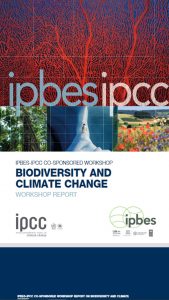 In December 2020, 50 of the world’s leading biodiversity and climate experts, selected by a 12-person Scientific Steering Committee assembled by IPBES (Intergovernmental Science-Policy Platform on Biodiversity and Ecosystem Services) and IPCC (Intergovernmental Panel on Climate Change), participated in a four-day virtual workshop to examine the synergies and trade-offs between biodiversity protection and climate change mitigation and adaptation. This represents the first-ever collaboration between the two intergovernmental science-policy bodies. The IPBES-IPCC co-sponsored workshop report on biodiversity and climate change, available below, was launched on 10 June 2021 at a virtual media conference.
In December 2020, 50 of the world’s leading biodiversity and climate experts, selected by a 12-person Scientific Steering Committee assembled by IPBES (Intergovernmental Science-Policy Platform on Biodiversity and Ecosystem Services) and IPCC (Intergovernmental Panel on Climate Change), participated in a four-day virtual workshop to examine the synergies and trade-offs between biodiversity protection and climate change mitigation and adaptation. This represents the first-ever collaboration between the two intergovernmental science-policy bodies. The IPBES-IPCC co-sponsored workshop report on biodiversity and climate change, available below, was launched on 10 June 2021 at a virtual media conference.
Participants also produced an associated Scientific Outcome, consisting of seven scientific sections, a list of about 1,500 literature references, a glossary and appendices.
The report finds that biodiversity loss and climate change are both driven by human economic activities and mutually reinforce each other. However, previous policies have largely tackled biodiversity loss and climate change independently of each other. Addressing the synergies between mitigating biodiversity loss and climate change, while considering their social impacts, offers the opportunity to maximize benefits and meet global development goals.
The authors also warn that narrowly-focused actions to combat climate change can directly and indirectly harm nature and vice-versa, but many measures exist that can make significant positive contributions in both areas. Among the most important available actions identified in the report are:
- Stopping the loss and degradation of carbon- and species-rich ecosystems on land and in the ocean,especially forests, wetlands, peatlands, grasslands and savannahs; coastal ecosystems such as mangroves, salt marshes, kelp forests and seagrass meadows; as well as deep water and polar blue carbon habitats. The report highlights that reducing deforestation and forest degradation can contribute to lowering human-caused greenhouse gas emissions, by a wide range from 0.4-5.8 gigatonnes of carbon dioxide equivalent every year.
- Restoring carbon- and species-rich ecosystems. The authors point to evidence that restoration is among the cheapest and quickest nature-based climate mitigation measures to implement – offering much-needed habitat for plants and animals, thus enhancing resilience of biodiversity in the face of climate change, with many other benefits such as flood regulation, coastal protection, enhanced water quality, reduced soil erosion and ensuring pollination. Ecosystem restoration can also create jobs and income, especially when taking into consideration the needs and access rights of indigenous peoples and local communities.
- Increasing sustainable agricultural and forestry practicesto improve the capacity to adapt to climate change, enhance biodiversity, increase carbon storage and reduce emissions. These include measures such as diversification of planted crop and forest species, agroforestry and agroecology. Improved management of cropland and grazing systems, such as soil conservation and the reduction of fertilizer use, is jointly estimated by the report to offer annual climate change mitigation potential of 3-6 gigatonnes of carbon dioxide equivalent.
- Enhancing and better-targeting conservation actions, coordinated with and supported by strong climate adaptation and innovation. Protected areas currently represent about 15% of land and 7.5% of the ocean. Positive outcomes are expected from substantially increasing intact and effectively protected areas. Global estimates of exact requirements for effectively protected and conserved areas to ensure a habitable climate, self-sustaining biodiversity and a good quality of life are not yet well established but range from 30 to 50 percent of all ocean and land surface areas. Options to improve the positive impacts of protected areas include greater resourcing, better management and enforcement, and improved distribution with increased inter-connectivity between these areas. Conservation measures beyond protected areas are also spotlighted – including migration corridors and planning for shifting climates, as well as better integration of people with nature to assure equity of access and use of nature’s contributions to people.
- Eliminating subsidies that support local and national activities harmful to biodiversity – such as deforestation, over-fertilization and over-fishing, can also support climate change mitigation and adaptation, together with changing individual consumption patterns, reducing loss and waste, and shifting diets, especially in rich countries, toward more plant-based options.
The Belgian Biodiversity Platform (based at the Royal Belgian Institute of Natural Sciences) acts as the IPBES Belgian Focal Point. The focal point activities consist in involving Belgian experts and stakeholders in the IPBES work programme.

